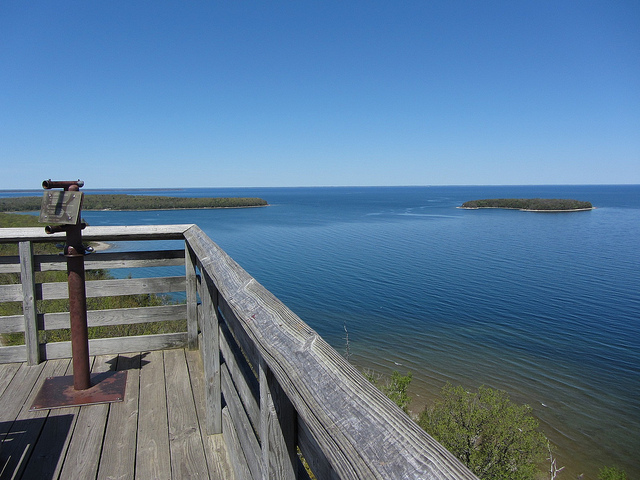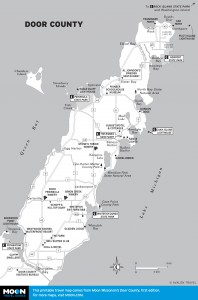
Eagle Tower in Wisconsin’s Peninsula State Park. Photo © Richie Diesterheft, licensed Creative Commons Attribution Share-alike.

Door County
The park comprises 3,800 variegated acres stretching from the northern fringe of Fish Creek, past Strawberry Channel, past Eagle Bluff, past Nicolet Bay, and finally to Eagle Harbor and Ephraim, all of it magnificent. Deeded to the state in 1909, Peninsula is the second-oldest park in the state system and the most visited—it draws more visitors per year than Yellowstone National Park.The peninsula, rising 180 feet above the lake at Eagle Bluff, is a manifestation of the western edge of the Niagara Escarpment, here a steep and variegated series of headlands and reentrants. The ecosystem is unparalleled: Near Weborg Point in the southwest, the Peninsula White Cedar Forest Natural Area is a 53-acre stand of spruce, cedar, balsam, and hemlock along with the boggy residual tract of an ancient lake. South of Eagle Tower is the larger 80-acre Peninsula Beech Forest Natural Area, a primitive example of northern mixed hardwood and also a relatively uncommon stand of American beech. Within both natural areas are a few threatened species, including the vivid dwarf lake iris. Other rarities include gaywings, Indian paintbrush, blue-eyed grass, and downy gentian. Be sure to stay for the sunset.
Like elsewhere, the first European in the area, Increase Claflin, was a squatter; he built his cabin high above the Strawberry Islands in 1844. Encampments of the Plano people have been examined that date to 7000-4000 BC, and the Menominee, Fox, Winnebago, Iroquois, and Potawatomi peoples have all occupied lakeside sites. The Native American presence and unusually harmonious relations with them are symbolized by the Memorial Pole. This 40-foot totem pole commemorates Potawatomi chief Simon Khaquados, laid to rest here in 1930 before thousands of admirers. Unfortunately, the newcomers didn’t love him enough to preclude building a golf course around his grave; the pole today sits between the 1st and 9th fairways.
A must-see is the Eagle Bluff Lighthouse (920/421-3636), built during the Civil War by U.S. lighthouse crewmen as the second of the peninsula’s lighthouses, a square tower about 45 feet tall attached to the keeper’s house. It stands atop the bluff and can be seen for 15 miles; the views from its top stretch even farther. The prize assignment for lighthouse keepers on the peninsula, it had a commanding view and the best salary, the princely sum (for 1880) of $50 per month. Public interest prompted local historical societies to peel off 80 layers of paint and set to work refurbishing the lighthouse in the late 1950s. Tours ($5 adults) are given in early summer and autumn every 30 minutes 10am-4:30pm Monday-Friday, with shorter hours the rest of year.
Two 75-foot towers were erected at the park’s inception and used as fire-spotting towers (one was later removed because of dry rot). Eagle Tower was built because so many people wanted to view a pair of long-term nesting eagles— the two for whom the bluff, the harbor, and the peninsula were eventually named.
Before going hiking, most visitors head to the White Cedar Nature Center (Bluff Rd., 920/854-5976, 10am-2pm daily Memorial Day-Labor Day, shorter hours Labor Day- Memorial Day) to walk a nature trail and view a host of exhibits covering the park’s natural history.
Deemed by the golf press one of the gems of Midwestern courses, this 18-holer is in the eastern part of the park. The Peninsula State Park Golf Course was built by a group of Ephraim businessmen in the early 1900s as a nine-hole course with sand greens. Tee-time reservations (920/854-5791) are required at this busy course, and make them as early as possible.
More than 20 miles of hiking trails lace the park and the shores of the bays. After parking and checking out Eagle Tower in the northern section of the park, ambitious visitors can take Minnehaha Trail (easy, 0.5 miles) or Sentinel Trail (easy, 2-mile loop) for some grand hiking. Minnehaha also connects to the South Nicolet Bay campground (near site 844) and runs along the lakeshore with great bay vistas; Sentinel runs through stands of maple, birch, and red pine, and 0.5 miles is surfaced with gravel for accessibility. The moderately difficult 0.5-mile spur Lone Pine Trail, off Sentinel Trail, leads up a dolomite bluff and through beech and oak trees, at one point passing a the trail’s solitary pine tree, now fallen along the trail. The toughest trail, but also the most rewarding, is Eagle Trail, skirting the harbor and a couple of natural springs for two miles and affording challenging scrambles over 200-foot bluffs; it’s a workout, but you’ll see lots of trilliums and thimbleberries.
In the north and west sections of the park, there are a couple of must-hike trails. In the north, so many people hiked from Nicolet Bay to Eagle Bluff lighthouse through cool stands of trees that an easy 0.5-mile trail was blazed, now dubbed the Trail Tramper’s Delight Trail. Also from Welcker’s Campground at Nicolet Bay, the 2.2-mile (one-way) Nicolet Bay Trail is a good bet for birders; you’ll likely see wild turkeys.
At its halfway point, the Nicolet Bay Trail connects with two great trails, both moderately difficult. The two-mile Hemlock Trail rises up a modest bluff to great views of the Strawberry Islands, and the three-mile loop Skyline Trail rises up minor Sven’s Bluff and past the remains of old homestead farms and fences, now decaying gracefully in the grasses and meadows.
There are 15 miles of road and off-road bike trails; a state trail pass is required. What may be the most heavily used recreational trail—Sunset Trail—starts near the park entrance and roughly parallels Shore Road for nearly five miles through marsh and stands of hardwoods and conifers and along the lakeside perimeter of Nicolet Bay Beach, at which point lovely back roads lead back to the park entrance. At dusk it is definitely not misnamed. Remember that this trail is multiuse, meaning pedestrian and wheelchair traffic; wheels yield to heels.
Bicycle rentals ($25 per day) are available at Nicolet Beach Concessions (920/854-9220) in the northern end of the park.
You won’t forget a kayak or canoe trip to Horseshoe Island, which has its own one-mile trail. It is rugged and definitely isolated even though it’s only a mile from Nicolet Bay. Kayakers and canoeists love Tennison Bay on the west side of the park due to its shallow draft. Kayak rentals ($50 per day) are available from Nicolet Beach Concessions (920/854-9220).
Camping was once allowed almost anywhere in Peninsula State Park and was either free or cost $0.50 per week. Today, the state Department of Natural Resources receives up to 5,000 applications for summer reservations in January. At last count there were 469 campsites in five sectors, and even though 25 are not reservable, it’s almost impossible to get a site without a reservation (888/947-2757, $15), especially on a Friday.
Only one sector is open year-round. All sectors have showers, but a couple have no electrical hookups. Many people prefer South Nicolet Bay (143 sites) since it’s large, has electrical hookups, and is closest to the sandy beach. You have to reserve early in January to get a waterside site. North Nicolet Bay campground (44 sites) is also not far from the beach but is smaller and has no electricity. Early reservations are also a must to get a waterside site. The park’s largest campground is Tennison Bay (188 sites); this is also the accessible campground. There is no beach nearby, however, and no waterside sites. Weborg Point (12 sites) and Welcker’s Point (81 sites) fill up last. Given the small size, Weborg should be quieter, but the electrical hookups mean there is generator noise; it does have waterside sites. Welcker’s Point, without electrical hookups, is quieter.
Excerpted from the First Edition of Moon Wisconsin’s Door County.